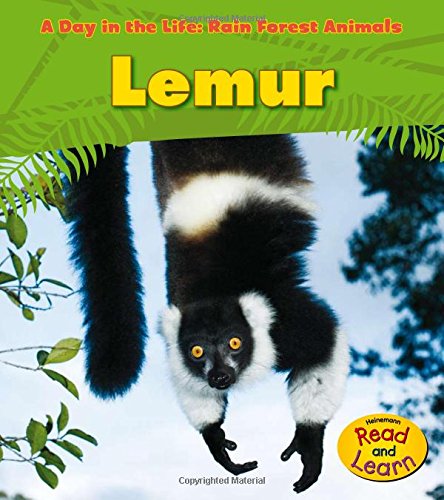-
Lemur
Anita Ganeri
Paperback (Heinemann, Sept. 1, 2010)Found only in Madagascar, lemurs have unique physical characteristics as well as interesting eating, sleeping, and social habits. Read about a day in the life of these fascinating creatures to gain a better understanding of their place among primates. L
L
-
Macaw
Anita Ganeri
Paperback (Heinemann, Sept. 1, 2010)Colorful birds, macaws are part of the parrot family. As you follow a macaw through its day, you'll learn how this brilliant coloring benefits the bird, what other physical characteristics enable it to move through the rain forest, and what it eats and where it sleeps. Its social system and method of communication are also explored. M
M
-
Porcupines
Joann Early Macken
Library Binding (Weekly Reader/Gareth Stevens Pub, July 1, 2009)Fascinating forest creatures fill the pages of this exciting series. Redesigned with new features, each book invites readers to discover the world of creatures that make their home deep in the woods. Young learners will read about each animals unique physical characteristics, behavior, and adaptations to their environment. Through fascinating facts and brilliant photographs, these books paint a vibrant picture of the incredible array of animal life in the forest habitat. J
J
-
Owls
Joann Early Macken
Paperback (Weekly Reader/Gareth Stevens Pub, July 1, 2009)An owl flies silently through the dark night, searching for food. The bird is alert to any movement on the ground. In an instant, the owl swoops down to snatch its meal. In Owls, learn how a tiny, fluffy owlet grows into a deadly hunter. J
J
-
Capybara
Anita Ganeri
Paperback (Heinemann, Sept. 1, 2010)Readers might be unfamiliar with the world's largest rodent before they read this book, but they won't forget about it afterward! Along with photos illustrating the amazing physical features of this four-foot-long creature, this book provides details about where the capybara is found, the kind of groups it lives in, what it eats, and how it protects itself. L
L
-
Caribou
Roman Patrick
Paperback (Gareth Stevens Leveled Readers, Aug. 15, 2010)Caribou are tundra animals that have long held a special place in cultures around the world. Known as reindeer when raised by people, caribou are distinctive for their elaborate antlers and camouflage coats. Readers will follow these hoofed animals as they travel thousands of miles each year searching for food to survive the cold, snowy tundra of the Arctic. Additional tidbits are shared through fact boxes, which are a great source for report writing and essays. N
N
-
Porcupines
Joann Early Macken
Paperback (Weekly Reader/Gareth Stevens Pub, July 1, 2009)In Porcupines, meet a strange-looking creature with a special way of staying safe. This amazing animal is perfectly suited to survive the dangers of the forest. Quills are the porcupines secret weapon. It uses these sharp, spiny hairs to protect itself from enemies. J
J
-
Arctic Hares
Therese M Shea
Paperback (Gareth Stevens Leveled Readers, Aug. 15, 2010)Arctic hares are specially suited for life in the snowy, icy Arctic. Their fur matches the tundra terrain so they are not easily spotted. When they do need to run, they use their long hind legs to bound across land at high speeds. They have also been spotted standing on two legs to box each other. This captivating book shows these furry creatures using their adaptations to survive in one of the coldest and harshest places on Earth. Fun fact boxes support the main narrative. I
I
-
Goats
Joann Early Macken, Ph.D. Clidas, Jeanne
Paperback (Weekly Reader/Gareth Stevens Pub, July 1, 2009)Fascinating farm animals fill the pages of this exciting series. Redesigned with new features, each book invites readers to discover the world of creatures that make their home on the farm. Young learners will read about each animals unique physical characteristics, behavior, and adaptations to their environment. Through fascinating facts and brilliant photographs, these books paint a vibrant picture of the incredible array of life on the farm. C
C
-
Snowy Owls
Roman Patrick
Paperback (Gareth Stevens Leveled Readers, Aug. 15, 2010)Introduces snowy owls who live in the tundra near the Arctic Ocean, describing their physical characteristics, life cycle, and feeding habits. M
M

